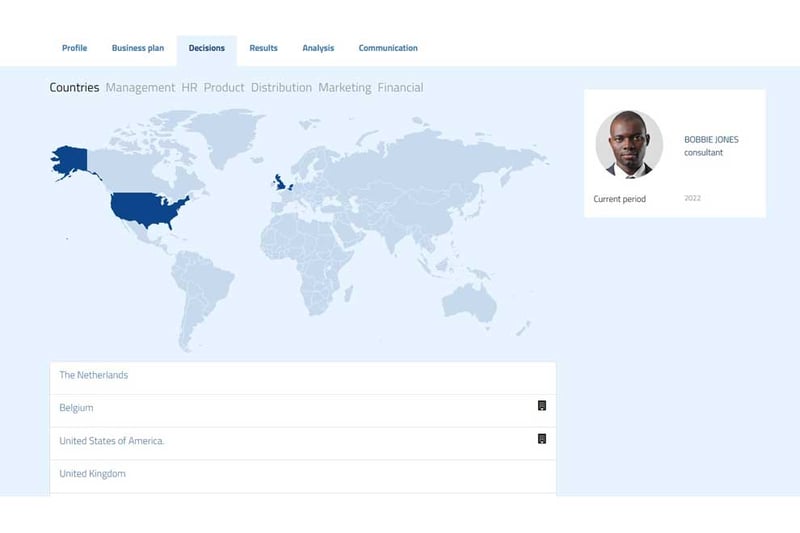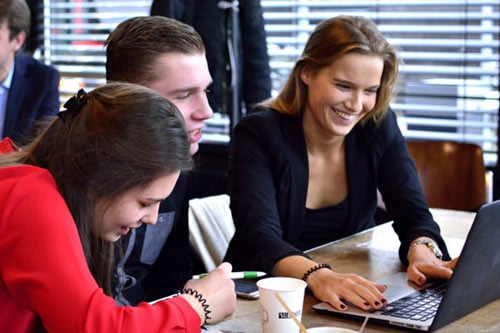"Authenticity, for me, is about how knowledge will be used in a real-life context. We're trying to, in a sense, build in the idea of real-life experience within modules that we teach."
Dr. Vincent Rich, Principal Lecturer, University of Westminster
Earlier this year the Financial Times wrote about the pressures MBA Professors are under to provide 'business relevance' in their teaching. Moving away from solely the 'Sage on the Stage', instructor-led teaching to new formats that are able to equip students with the hard and soft skills industry recruiters expect and ultimately provide the ROI for students investing in the qualification.
Indeed, this applies not only to MBA professors but academics across business education. Looking for answers to the question: "How can we create learning experiences that are engaging and equip and prepare our students for the world of work?"
One approach is through the use of business simulations as an experiential learning tool. Learning by doing not only creates fun, engaging environments for students but can equip them with valuable employability skills. Business simulations serve as excellent experiential learning tools because not only do they create these engaging environments fostering skills development but they can also inject a dose of realism into the mix.
In this blog article we highlight four ways in which business simulations create experiences for students that emulate the real-world of business.
1. Student-led learning - Arise, the "Guide on the Side"
"It was like adopting a new way of learning. I wanted students to take charge of their learning." This was Dr. Charles Bladen's take on using simulations in his undergraduate Tourism Management-2.jpeg?width=290&name=WhatsApp%20Image%202021-11-24%20at%209.23.09%20AM%20(1)-2.jpeg) module.
module.
In a business simulation exercise, the Instructor, quite simply, does not know the answers. While, yes, they know the tried and tested models and methods to design a business strategy and provide good insights to respond to market changes, wat they do not know exactly is the extent to which this will improve company performance.
Students are in the driving seat here. No longer the passenger in the back observing and learning from the expert. They're the ones in charge of their own learning experience. So, for instance, when they choose to invest in a new HR Manager for their company, they do not know for certain whether this will improve staff recruitment and retention and therefore improve company output. They're taking - hopefully - calculated risks. Just as we do in business.
Albeit in a safe, fictional environment, students are making the same managerial and strategic decisions as those in the real-world.
Instructors' roles here revert from the 'Sage on the Stage' to the 'Guide on the Side', coaching students to apply subject knowledge and team-working skills but not being the one with all of the answers to the task itself.
2. working in teams - Being a "Team-player"
"Must be able to work effectively in a team'; 'a team-player with strong inter-personal skills'. There's a good chance you've seen statements like these in job descriptions you've either written or viewed. Team-working is a core soft-skill required in business because rarely do employees operate solely on their own 100 percent of the time. They must work together across departments to achieve a shared objective - regardless of how important or easy/hard that objective is.
In a business simulation exercise, students are placed in teams where they must decide what role each of them will play in the company and together determine what their company's strategy will be. Rarely are these roles decided for them and more often than not they're working with students they either haven't met or do not know well.
Furthermore, they're exposed to all the functions of a business, from marketing to HR, Finance to Legal, here students can piece together the components of a business and see how they interact with one another.
it's in this environment that students can really discover more about what kind of professional they want to be: are they a leader? Clear and forthright on what their company's strategy should be; or are they more analytical? Keen to look at the company's data and commission market research; or are they more people-focussed? Looking at their workforce and recruitment and retention patterns.
The simulation provides an environment where they realise both the importance of team-working in business and also what professional personas they adopt in this setting.
Dr. Anna Tilba, Senior Lecturer from the University of Durham summed this up nicely during our student engagement webinar:
“We’re trying to train and prepare students for the real world. In the real world we have to work with different people…it’s also a journey for students to learn more about who they are. Are they leaders, good team players? Those who are not as competitive could be really good at other areas such as data analysis and finance.”
3. Context and Environment - ensuring a Realistic Setting
For all the student-led learning and team-working skills that can be developed, this can be somewhat diluted if the simulation itself is unrealistic and not aligned with real-world industries and markets. If students were to manage companies where each has an equal share of the market and through each round this market remains static, operating with huge, unrestrained budgets and limited legal regulations, then sure enough they've got an exercise at odds with the real-world. 
In our business simulations, each are based on existing industries aligned to real-world regulations and changes in the market. They're operating with realistic profit and loss data and often have to make tough decisions to cut costs sometimes at the expense of their own workforce.
The Business Consultancy simulation is a great example of the harsh but realistic contexts of business management. Here they form an external consultancy team, employed to turn around a failing business. They firstly must take a look at the data to understand why the company has been performing so poorly then produce a business plan to turn it into a profitable entity. Through each round they need to adapt to changes in the market that may change their initial investment decisions.
Ensuring a realistic setting starts with the simulation itself followed by the pedagogical approach.
4. Summative Assessment - From business cases to marketing plans
Fostering a realistic task and environment does not stop once the simulation has finished. Indeed, it can be the perfect platform to provide students with an assignment, much like those expected in the business world, at the end of their course/module.
For example, on Nick Pronger's 'Marketing Simulation' module at Birkbeck University of London, after taking part in the My Marketing Experience simulation where teams of students manage their own jeans brand, individual students are then asked to design their company's marketing strategy for the year ahead. Here they need to utilise models and concepts they've learned in previous modules and apply them to the context of their company in the simulation.
and apply them to the context of their company in the simulation.
Similar instances include delivering presentations on their company's performance that evaluate their strategy's strengths and weaknesses. Designing follow-up strategies and delivering presentations reporting on company performance are again common tasks expected in the world of business.
By using a summative assignment students are able to recall and directly apply what they've learned from the simulation exercise and place it into a realistic task - one that is likely to be expected of them by their future business managers.
Ensuring curricula is aligned to the 'relevance' of the world of business will always be a challenge for academics in business education.
Embedding a business simulation exercise provides a valuable jigsaw piece to solving this puzzle.
INTERESTED IN USING BUSINESS SIMULATIONS?
Click on the button below to view our catalogue.
CASE STUDIES
Check out our library of case studies to see how our academic partners have used simulations in their teaching.
Edumundo is proud to feature in Feedspot's 15 best Business Education Blogs!




.png?length=300&name=unnamed%20(11).png)
.png?length=300&name=unnamed%20(7).png)
.png?length=300&name=unnamed%20(8).png)
.png?length=300&name=unnamed%20(6).png)

.png?length=300&name=unnamed%20(10).png)
.png?length=300&name=unnamed%20(5).png)
.png?length=300&name=unnamed%20(9).png)
.png?length=300&name=unnamed%20(4).png)
.png?length=300&name=unnamed%20(2).png)
.png?length=300&name=unnamed%20(1).png)
.png?length=300&name=unnamed%20(3).png)
.jpg?length=300&name=unnamed%20(2).jpg)





.png?length=300&name=loughborough-university-logo%20(small).png)





